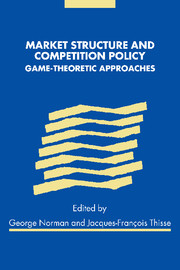Book contents
- Frontmatter
- Contents
- List of figures
- List of tables
- List of contributors
- Louis Phlips: a brief biography
- Introduction
- 1 Competition policy and game-theory: reflections based on the cement industry case
- 2 Legal standards and economic analysis of collusion in EC competition policy
- 3 A guided tour of the Folk Theorem
- 4 Predatory pricing and anti-dumping
- 5 Should pricing policies be regulated when firms may tacitly collude?
- 6 Tougher price competition or lower concentration: a trade-off for anti-trust authorities?
- 7 The strategic effects of supply guarantees: the raincheck game
- 8 Product market competition policy and technological performance
- 9 On some issues in the theory of competition in regulated markets
- 10 Modelling the entry and exit process in dynamic competition: an introduction to repeated-commitment models
- 11 Coordination failures in the Cournot approach to deregulated bank competition
- 12 How the adoption of a new technology is affected by the interaction between labour and product markets
- Index
6 - Tougher price competition or lower concentration: a trade-off for anti-trust authorities?
Published online by Cambridge University Press: 22 September 2009
- Frontmatter
- Contents
- List of figures
- List of tables
- List of contributors
- Louis Phlips: a brief biography
- Introduction
- 1 Competition policy and game-theory: reflections based on the cement industry case
- 2 Legal standards and economic analysis of collusion in EC competition policy
- 3 A guided tour of the Folk Theorem
- 4 Predatory pricing and anti-dumping
- 5 Should pricing policies be regulated when firms may tacitly collude?
- 6 Tougher price competition or lower concentration: a trade-off for anti-trust authorities?
- 7 The strategic effects of supply guarantees: the raincheck game
- 8 Product market competition policy and technological performance
- 9 On some issues in the theory of competition in regulated markets
- 10 Modelling the entry and exit process in dynamic competition: an introduction to repeated-commitment models
- 11 Coordination failures in the Cournot approach to deregulated bank competition
- 12 How the adoption of a new technology is affected by the interaction between labour and product markets
- Index
Summary
Introduction
Looking at the history of anti-trust laws, their first and possibly main objective seems to have been the forbidding of price collusion – that is, to prevent different sellers to agree in fixing the price of their product. For instance, the Sherman Act (1890) was, in its early period, generally interpreted as a law against cartels and moreover ‘in the enforcement of the Sherman Act against cartels, emphasis has been placed upon establishing the fact of an agreement pertaining to price’ (Posner, 1977, p. 213). The application of the Act to mergers came only later and was subject to controversy. Judges did not immediately use the argument that, by consolidation into a single-firm, cartel members could evade the law. As a result, following the Sherman Act, there was a sharp increase in the number of mergers in United States industry at the end of the nineteenth century as documented, among others, by Bittlingmayer (1985). More recently a similar evolution was observed in the European Community legislation. For years it had been discussed whether articles 85 and 86 of the Rome Treaty (1957), could have been directly applied to mergers and acquisitions. It was only in 1989 that a new regulation on such cases was adopted ‘in the 1992 perspective and given the corresponding wave of mergers and takeovers’.
- Type
- Chapter
- Information
- Market Structure and Competition PolicyGame-Theoretic Approaches, pp. 125 - 142Publisher: Cambridge University PressPrint publication year: 2000
- 3
- Cited by



